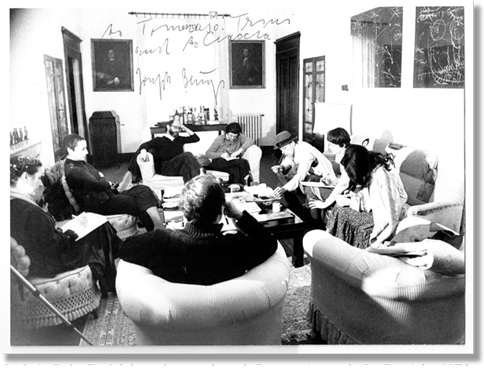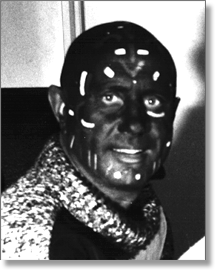- Italian
- English
- Deutch
- Français
 All’inizio degli anni Settanta in Italia una nuova rivista d’arte progettò di costituirsi al modo di un database degli eventi d’arte contemporanea in presa diretta. Ciò era suggerito dall’evolversi dei linguaggi creativi tra New York e Torino, Parigi e Roma, di cui la rivista voleva dare testimonianze documentarie le più esatte possibili.
All’inizio degli anni Settanta in Italia una nuova rivista d’arte progettò di costituirsi al modo di un database degli eventi d’arte contemporanea in presa diretta. Ciò era suggerito dall’evolversi dei linguaggi creativi tra New York e Torino, Parigi e Roma, di cui la rivista voleva dare testimonianze documentarie le più esatte possibili.
Data sarebbe stata rispettosa degli artisti: “l’arte è ciò che facciamo noi, la cultura è ciò che fanno di noi” (Carl Andre). Del resto, Arte Povera e Conceptual Art erano le basi degli anni Sessanta sulle quali si era formato il progetto editoriale, che prefigurava l'editoria informatica. Mancavano ancora i personal computer e si attraversava una crisi economica mondiale (’73). Ma l’artefatto era già de-materializzato, l’oggetto veniva sublimato dall’atto performativo, l’idea era il motore di atti creativi volti alla condivisione. Questa tempesta perfetta esigeva registrazioni tempestive.
 Tommaso Trini (Castelli) progettò Data nel 1970 per un editore di arte antica. Già collaborava a Domus con Ettore Sottsass jr. e si apprestava a scrivere sul Corriere della Sera con Maurizio Calvesi. Fu l’antiquario romano Gilberto Algranti a varare questa nuova rivista d’avanguardia accanto alla classica Arte Illustrata. Subito dopo l’antiquario rinunciò a operare nell’arte moderna. Data uscì nell’estate 1971 e nove mesi dopo nacque Jacopo.
Tommaso Trini (Castelli) progettò Data nel 1970 per un editore di arte antica. Già collaborava a Domus con Ettore Sottsass jr. e si apprestava a scrivere sul Corriere della Sera con Maurizio Calvesi. Fu l’antiquario romano Gilberto Algranti a varare questa nuova rivista d’avanguardia accanto alla classica Arte Illustrata. Subito dopo l’antiquario rinunciò a operare nell’arte moderna. Data uscì nell’estate 1971 e nove mesi dopo nacque Jacopo.
TTrini continuò la pubblicazione della nuova rivista con Ciacia Nicastro, già collaboratrice di Carlo Cardazzo e Gabriele Mazzotta, presso il giovane editore Giampaolo Prearo. Storici e critici di notevole valore come Mirella Bandini, Renato Barilli, Alberto Boatto, Achille Bonito Oliva, Clino (Trini) Castelli, Michel Claura,  Klaus Honnef, Daniela Palazzoli, Filiberto Menna, Lea Vergine, continuarono a contribuirvi con saggi e dibattiti. Nella sua redazione esordirono giovani critici quali Jole De Sanna, Bruno Corà e Barbara Radice.
Klaus Honnef, Daniela Palazzoli, Filiberto Menna, Lea Vergine, continuarono a contribuirvi con saggi e dibattiti. Nella sua redazione esordirono giovani critici quali Jole De Sanna, Bruno Corà e Barbara Radice.
Data durò sette anni. Dalla prima copertina di Luciano Fabro, in cui una zampa di cristallo con pantalone di seta (arte povera) avanzava idealmente tra gli elefanti della storia, alla copertina finale di Mimmo Paladino dalla quale si affacciava il nomadismo dei segni di una metafisica rinnovata (transavanguardia), Data documentò l’intero decennio. Fu chiusa nell’estate 1978. Nel frattempo Ciacia Trini si era ammalata gravemente.
 In the early 1970s in Italy, a new art magazine planned to set itself up in the form of a database of contemporary art events live. The idea was prompted by the development of creative languages between New York and Turin, Paris and Rome, which this project aimed to accurately testify.
In the early 1970s in Italy, a new art magazine planned to set itself up in the form of a database of contemporary art events live. The idea was prompted by the development of creative languages between New York and Turin, Paris and Rome, which this project aimed to accurately testify.
Data would respect artists: “Art is what we do, culture is what they do of us” (Carl Andre). After all, Arte Povera and Conceptual Art were the foundations of the 1960s on which this publishing project had formed itself, whose target was computer publishing. Personal computers were not yet available and then came a global economic crisis (’73). However, the artefact was de-materialized, the object was sublimated by the performing act, the idea was the engine of creative acts to share. This “perfect storm” required timely recordings.
Tommaso Trini (Castelli) planned Data in 1970 for an ancient art publisher. He was already working at Domus with Ettore Sottsass jr. and was about to write in the Corriere della Sera with Maurizio Calvesi. Rome antique dealer Gilberto Algranti gave life to this new avant-garde magazine, alongside the more classic Arte Illustrata (Arts Illustrated). Immediately after, the antique dealer gave up working with modern art. Data was issued in the summer of 1971 and Jacopo was born nine months later.

TTrini continued publishing the new magazine with Ciacia Nicastro, who had previously worked with Carlo Cardazzo and Gabriele Mazzotta, with the young publisher Giampaolo Prearo. Very valuable historians and critics such as Mirella Bandini, Renato Barilli, Alberto Boatto,  Achille Bonito Oliva, Clino (Trini) Castelli, Michel Claura, Klaus Honnef, Daniela Palazzoli, Filiberto Menna, Lea Vergine, continued to contribute to it with their essays and debates. Young critics such as Jole De Sanna, Bruno Corà and Barbara Radice started working in his editorial office.
Achille Bonito Oliva, Clino (Trini) Castelli, Michel Claura, Klaus Honnef, Daniela Palazzoli, Filiberto Menna, Lea Vergine, continued to contribute to it with their essays and debates. Young critics such as Jole De Sanna, Bruno Corà and Barbara Radice started working in his editorial office.
The publication lasted seven years. From the first cover by Luciano Fabro, where a glass animal leg with silk trousers (arte povera) figuratively moved among the elephants of history, to the final cover by Mimmo Paladino which depicted the nomadism of the signs of a renewed metaphysics (trans-avant-garde), Data documented the whole decade. It was closed in the summer of 1978. Meanwhile Ciacia Trini had fallen seriously ill.
 Zu Beginn der 1970er Jahre sollte eine italienische Kunstzeitschrift nach dem Modell einer Datenbank von Veranstaltungen zur zeitgenössischen Kunst in Echtzeit strukturiert werden. Der Impuls entsprang der Entwicklung der künstlerischen Formsprachen in New York, Turin, Paris und Rom, über die in der Zeitschrift wahrheitsgetreu berichtet werden sollte.
Zu Beginn der 1970er Jahre sollte eine italienische Kunstzeitschrift nach dem Modell einer Datenbank von Veranstaltungen zur zeitgenössischen Kunst in Echtzeit strukturiert werden. Der Impuls entsprang der Entwicklung der künstlerischen Formsprachen in New York, Turin, Paris und Rom, über die in der Zeitschrift wahrheitsgetreu berichtet werden sollte.
Data wollte Achtung vor den Künstlern zeigen: „Das, was wir machen, ist Kunst; Kultur ist, was die anderen aus uns machen“ (Carl Andre). Arte Povera und Konzeptkunst waren die Grundlagen, auf denen in den 60er Jahren das Verlagsprojekt beruhte, dessen Zielvorstellung ein informatisches Verlagswesen war. Es gab noch keine Personal Computer und 1973 war das Jahr der Weltwirtschaftskrise. Das Artefakt war jedoch dematerialisiert, der Gegenstand wurde durch den performativen Akt sublimiert, die Idee war die Antriebskraft jedes schöpferischen Handelns, das geteilt werden sollten. Dieser „perfekte Sturm“ musste zeitnah aufgezeichnet werden.
Tommaso Trini (Castelli) plante Data 1970 für einen Verleger Alter Musik. Er arbeitete bereits bei Domus mit Ettore Sottsass jr. zusammen und sollte wenig später mit Maurizio Calvesi im Corriere della Sera schreiben.  Der römische Antiquar Gilberto Algranti gab die neue avantgardistische Zeitschrift 1971 gemeinsam mit dem klassischeren Titel Arte Illustrata heraus. Kurz danach gab der Antiquar seine Tätigkeit im Bereich der Modernen Kunst auf. Data erschien im Sommer 1971 und neun Monate später kam Jacopo zur Welt.
Der römische Antiquar Gilberto Algranti gab die neue avantgardistische Zeitschrift 1971 gemeinsam mit dem klassischeren Titel Arte Illustrata heraus. Kurz danach gab der Antiquar seine Tätigkeit im Bereich der Modernen Kunst auf. Data erschien im Sommer 1971 und neun Monate später kam Jacopo zur Welt.
TTrini setzte die Veröffentlichung der neuen Zeitschrift mit Ciacia Nicastro fort, die bereits für Carlo Cardazzo und Gabriele Mazzotta bei dem jungen Verleger Giampaolo Prearo arbeitete. Renommierte Historiker und Kritiker wie Mirella Bandini, Renato Barilli, Alberto Boatto, Achille Bonito Oliva, Clino (Trini) Castelli, Michel Claura, Klaus Honnef, Daniela Palazzoli, Filiberto Menna und Lea Vergine leisteten Beiträge in Form von Essays und Debatten. In der  Redaktion machten junge Kritiker wie Jole De Sanna, Bruno Corà und Barbara Radice ihre ersten Schritte.
Redaktion machten junge Kritiker wie Jole De Sanna, Bruno Corà und Barbara Radice ihre ersten Schritte.
Die Zeitschrift wurde sieben Jahre lang veröffentlicht. „Data“ dokumentierte ein Jahrzehnt: von der ersten Titelseite von Luciano Fabro, auf der eine Kristallpfote mit Seidenhose (Arte Povera) ideell ihren Platz zwischen den Elefanten der Geschichte einnahm, bis zum letzten Heft mit der Titelseite von Mimmo Paladino, auf der der Nomadismus der Zeichen einer neuen Metaphysik (Transavantgarde) in den Vordergrund trat. 1978 wurde das Erscheinen infolge einer schweren Krankheit von Ciacia Trini eingestellt.
 Au début des années 1970 en Italie un nouveau magazine d’art eut l’idée de s’organiser comme une base de données des événements d’art contemporains en prise directe. Cette idée était issue de l’évolution des langages créatifs entre New York et Turin, Paris et Rome, dont le projet souhaitait apporter des témoignages précis.
Au début des années 1970 en Italie un nouveau magazine d’art eut l’idée de s’organiser comme une base de données des événements d’art contemporains en prise directe. Cette idée était issue de l’évolution des langages créatifs entre New York et Turin, Paris et Rome, dont le projet souhaitait apporter des témoignages précis.
Data serait respectueux des artistes : « L’art est ce que nous faisons, la culture est ce qu’on fait de nous » (Carl Andre). Du reste, Arte Povera et Conceptual Art constituaient les bases des années 1960 sur lesquelles on avait construit le projet éditorial préfiguré comme informatique. Les microordinateurs n’étaient pas encore là et on traversa une crise économique mondiale (1973). Mais l’artefact était dématérialisé, l’objet était sublimé par l’acte de la performance, l’idée était le moteur des actes créatifs à partager. Cette « tempête parfaite » exigeait des enregistrements effectués en temps utile.
 Tommaso Trini (Castelli) conçut Data en 1970 pour un éditeur d’art ancien. Il participait déjà à Domus avec Ettore Sottsass jr. et il s’apprêtait à écrire dans le Corriere della Sera avec Maurizio Calvesi. Ce fut l’antiquaire romain Gilberto Algranti à lancer en '71 le nouveau magazine d’avant-garde à côté du plus classique Arte Illustrata. Tout de suite après l’antiquaire renonça à travailler dans l’art moderne. Data parut en été 1971 et neuf mois après Jacopo vit le jour.
Tommaso Trini (Castelli) conçut Data en 1970 pour un éditeur d’art ancien. Il participait déjà à Domus avec Ettore Sottsass jr. et il s’apprêtait à écrire dans le Corriere della Sera avec Maurizio Calvesi. Ce fut l’antiquaire romain Gilberto Algranti à lancer en '71 le nouveau magazine d’avant-garde à côté du plus classique Arte Illustrata. Tout de suite après l’antiquaire renonça à travailler dans l’art moderne. Data parut en été 1971 et neuf mois après Jacopo vit le jour.
TTrini continua la publication du nouveau magazine avec Ciacia Nicastro, qui avait déjà collaboré avec Carlo Cardazzo et Gabriele Mazzotta, pour le jeune éditeur Giampaolo Prearo. Des historiens et des critiques d’une valeur remarquable comme Mirella Bandini, Renato Barilli, Alberto Boatto, Achille Bonito Oliva, Clino (Trini) Castelli, Michel Claura, Klaus Honnef, Daniela Palazzoli, Filiberto Menna, Lea Vergine, continuèrent à y contribuer avec leurs essais et leurs débats.  De jeunes critiques comme Jole De Sanna, Bruno Corà et Barbara Radice débutèrent dans sa rédaction.
De jeunes critiques comme Jole De Sanna, Bruno Corà et Barbara Radice débutèrent dans sa rédaction.
La publication dura sept ans. De la première couverture de Luciano Fabro, où une patte de cristal en pantalon de soie (Arte Povera) avançait idéalement parmi les éléphants de l’histoire, à la dernière couverture de Mimmo Paladino, où le nomadisme des signes d’une métaphysique renouvelée (trans-avant-garde) faisait surface. Data documenta toute la décennie. Il fut fermé en été 1978. Entre-temps Ciacia Trini était tombée gravement malade.